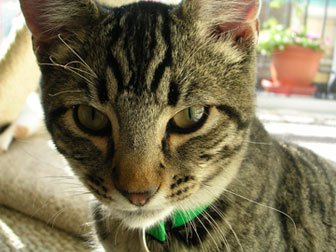Cat domestication tied to rise of agriculture
Cat domestication tied to rise of agriculture
mongabay.com
July 1, 2007
Researchers trace origin of domesticated cats to wildcat from the deserts of the Middle East.
A new study traces the domestication of house cats to the emergence of agriculture in the Fertile Crescent some 10,000 years ago–not Egypt as previously presumed.
Writing in Science, a team of researchers led by Carlos Driscoll of the National Cancer Institute report that house cats are descendants of the Near Eastern wildcat, Felis silvestris lybica, which has been domesticated from at least five maternal lineages in Israel, Saudi Arabia and other countries in the Middle East.
The scientists sampled genetic material from 979 domestic cats and compared it with DNA sequences from five wild cat subspecies–the European wildcat, the Near Eastern wildcat, the Central Asian wildcat, the southern African wildcat, and the Chinese desert cat. They found that each of the subspecies, as well as domestic cats, fell into a group, or “clade,” that was genetically distinct, but that house cats appear most closely related to wildcats from the Middle East. The authors estimate that domestic cats split from Middle Eastern wildcats some 130,000 years ago–earlier than previously thought. The earliest archaeological evidence for cat domestication dates to 9,500 years ago from the island of Cyprus though researchers believe domestication occurred earlier, when farmers in the Middle East were probably the first to domesticate wild cats.
 “Jack”. While all house cats are closely related genetically, there is wide variation in coat color and other physical characteristics. |
According to the researchers, cats were probably domesticated once humans settled into villages and began farming. Stored grain would have attracted mice which, in turn, would have attracted cats. Villagers may have kept cats around as a way to control mice populations. Cats were later brought as pets to other parts of the world, including Europe, Asia, and the Americas.
The domestication of the cat, a carnivore, has had a significant impact on populations of small animals. America’s 90 million cats alone are estimated to killed anywhere from 120 million to more than 500 million birds annually. Hundreds of millions of rodents, reptiles, and amphibians also fall prey to cats each year.
C.A. Driscoll, M. Menotti-Raymond, A.L. Roca, W.E. Johnson and S.J. O’Brien (2007). The Near Eastern Origin of Cat Domestication. Science. 29 June 2007.